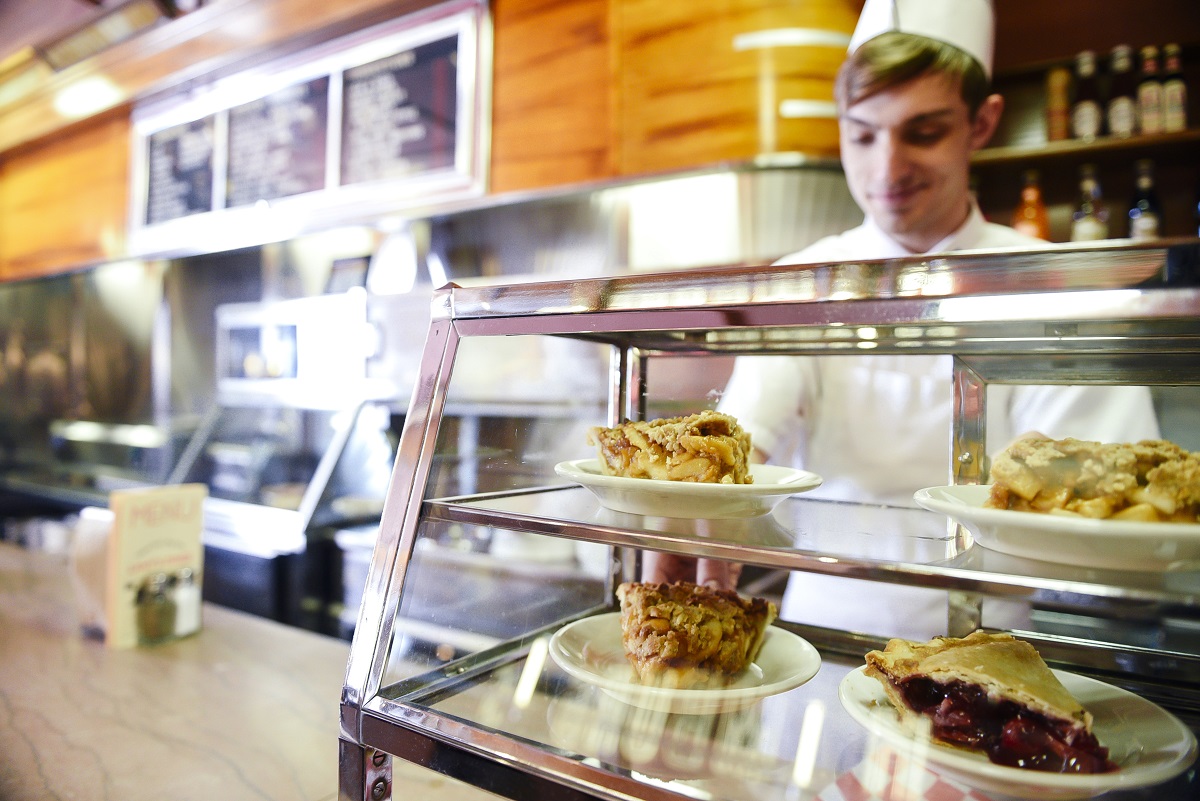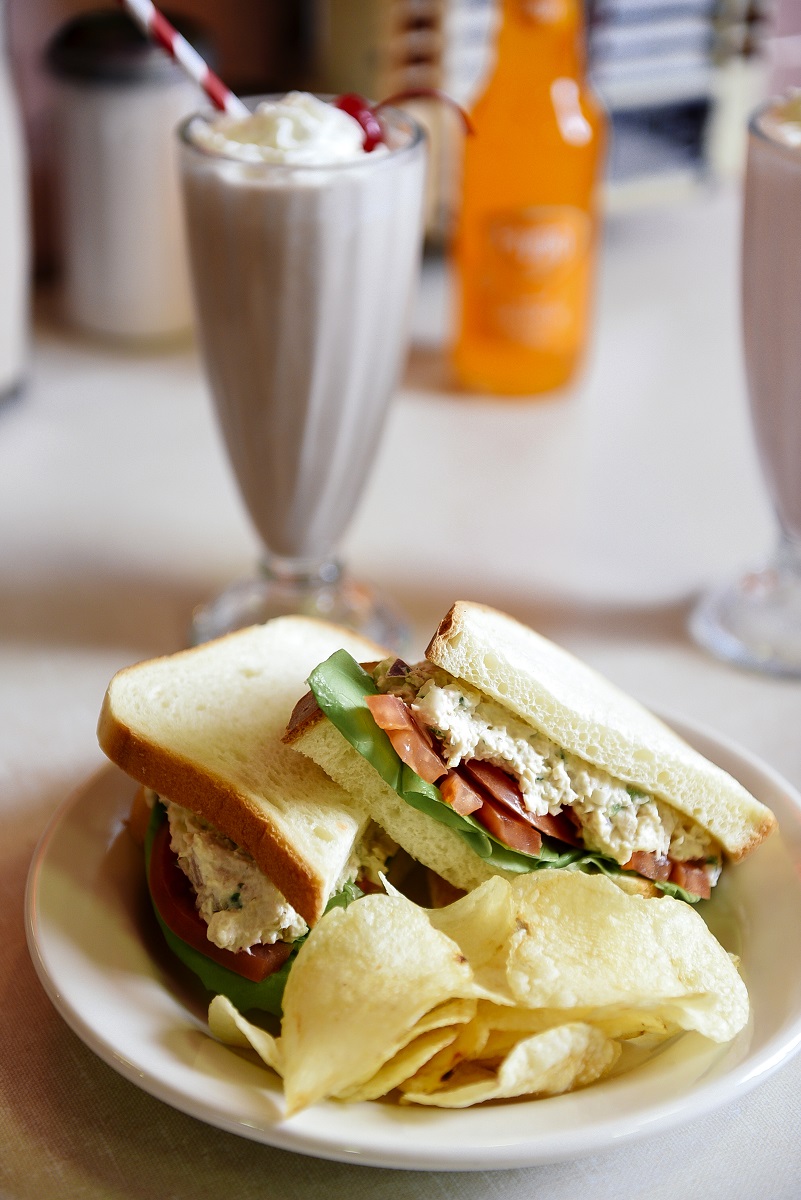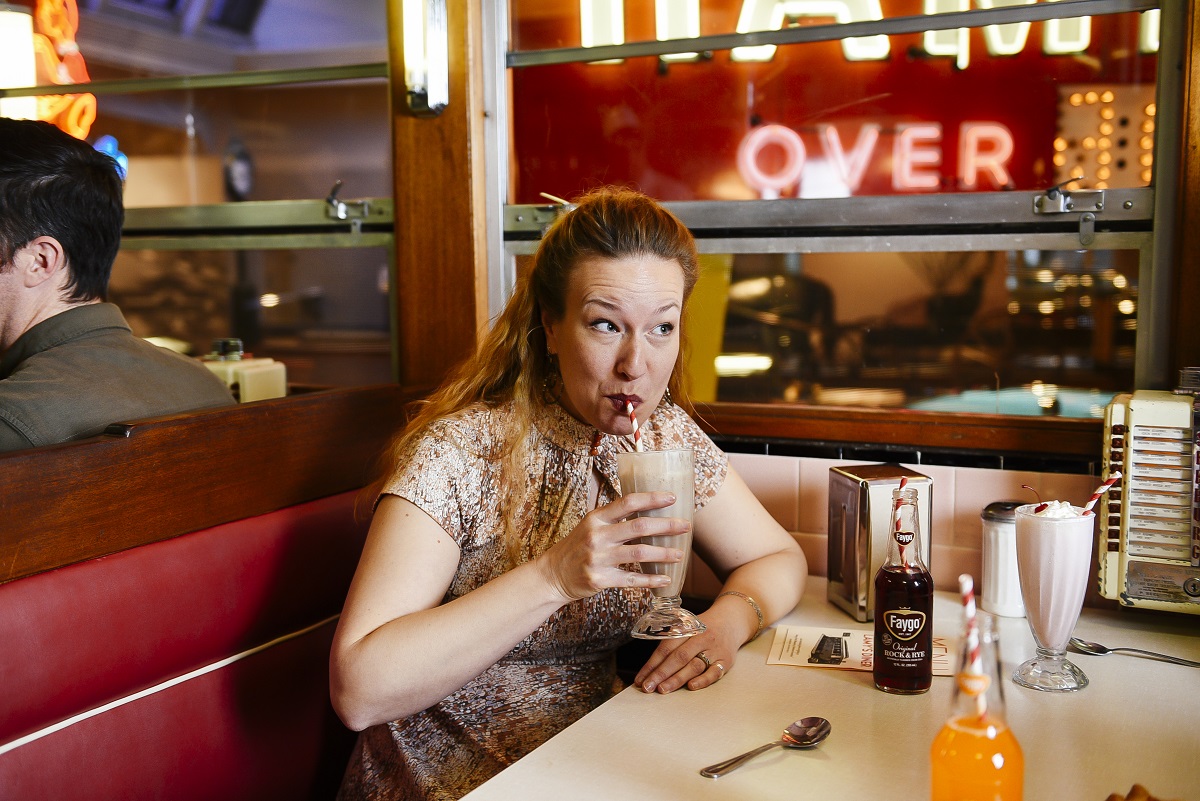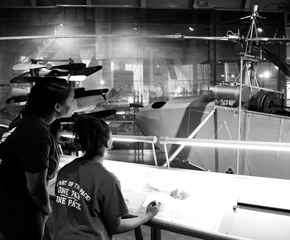Posts Tagged diners
Celebrating Lamy’s Diner
 Photo by Emily Berger
Photo by Emily Berger
This month we are excited to reopen a guest favorite inside Henry Ford Museum of American Innovation: Lamy's Diner, a must-stop destination closed for almost two years during the COVID-19 pandemic. Operating as a restaurant inside the museum since 2012, Lamy’s provides members and guests an authentic 1940s diner experience, complete with chicken salad sandwiches and frappes. (And Toll House chocolate chip cookies, of course!)
Photo by Emily Berger
In honor of Lamy’s reopening for daily dining, Eric Schilbe, Executive Sous Chef at The Henry Ford, shares two recipes that are crowd pleasers on the menu: tomato soup (an occasional special) and maple chicken salad. Try making these favorites at home, and then dig deeper into all-things Lamy’s in our Digital Collections.
Recipes
Lamy’s Tomato Soup
Makes about 4-5 bowls
Why we use this recipe:This is a very traditional tomato soup that has plenty of vegetable flavor and a touch of richness from the Parmesan cheese. (Psst! Don’t add the cheese until the very end!)
Ingredients
- 2T olive oil
- 1 large onion, diced
- 4 stalks small diced celery
- 2 carrots, chopped
- 1 bay leaf
- 1t dried basil
- 2 large cans diced tomato (plain – no seasoning)
- 1 cup half-and-half
- 1t pepper
- ¼ cup Parmesan cheese
Directions
- Cook the onions, carrots, and celery with oil in a stainless pot until completely tender.
- Add tomatoes, bay leaf, basil, and simmer about 30-40 minutes until completely cooked. (It should be a little darker than when you started.)
- Finish with half and half, Parmesan cheese, and pepper. Remove from heat.
- Using a blender, blend the soup until very smooth, and then serve immediately.
Chef’s Notes
- All canned tomatoes are not created equal! You may need to adjust with a little water or cook them down longer.
- Cook your vegetables until they are completely tender and falling apart—this will add richness to the flavor.
Lamy’s Maple Chicken Salad
Makes about 4-5 sandwiches
Why we use this recipe: Chicken salad can be such a simple recipe, but by adding maple syrup, a classic New England ingredient, and a touch of cumin, we set it apart from others.
Ingredients
- 2 large chicken breasts, cooked and cooled
- 4 stalks small diced celery
- ¼ minced red onion
- 1T yellow mustard
- 1T pure maple syrup
- ¼ cup mayonnaise
- 2T sour cream
- 1/4t cumin
- 1T fresh parsley, chopped fine
- 1t pepper
Directions
- Cook, cool, and pick the chicken. Place in a food processor and pulse until shredded fine.
- Add all other ingredients together and mix well.
- Let set, refrigerated, for 1-2 hours before serving.
Chef’s Notes
- During this era, the chicken was typically shredded very fine and simple ingredients were used. When making this at home, make sure the chicken is not overcooked and that it is very well shredded. This will make the salad moist and flavorful; you can always add a touch more mayonnaise.

Photo by Emily Berger
Dig Deeper: Lamy's Online
All About Lamy’s
- Plan Your Visit: Lamy’s Diner (find notes on visiting and hours)
- Lamy’s Diner, 1946 (check out the Lamy’s artifact page in our Digital Collections)
- Lamy’s: A Diner from the Golden Age (explore the history of Lamy’s on our blog)
- Lamy’s Gets a Makeover (2017) (learn about our 2017 updates to Lamy’s menu; note that additional changes have been made since)
- Lamy’s on TV: Mr. Coffee – The Henry Ford’s Innovation Nation
Diners, Drive-Ins... and Cookies
- Diners: An American Original (dig into the history of the diner on our blog)
- Dig Deeper: Owl Night Lunch Wagon (explore artifacts related to Greenfield Village’s own Owl Night Lunch Wagon)
- Inventing America’s Favorite Cookie (find out how America’s favorite cookie, the Toll House chocolate chip cookie, was born)
- Flipping Burgers into a Career (learn the story of Don Dunivent, who worked for White Castle from the 1920s through the 1950s)
- Dig Deeper: Lunch Wagons (check out artifacts related to lunch wagons in our Digital Collections)
More Historic Dining at The Henry Ford
- Creating the Eagle Tavern Dining Experience (go behind-the-scenes to learn how we developed the menu for Greenfield Village’s Eagle Tavern)
- Beyond the Peanut: Food Inspired by Carver (discover how agricultural scientist George Washington Carver’s own recipes provided inspiration for some of our recipes at A Taste of History and Plum Market Kitchen)
Lish Dorset is Marketing Manager, Non-Admission Products, and Eric Schilbe is Executive Sous Chef at The Henry Ford.
Additional Readings:
- Lamy's Diner
- Lamy's: A Diner from the Golden Age
- Lamy's Diner at Its Original Site in Marlborough, Massachusetts, circa 1946
- Diners: An American Original
COVID 19 impact, recipes, by Eric Schilbe, by Lish Dorset, food, Driving America, Henry Ford Museum, diners, restaurants
Diners: An American Original

In 1984, Henry Ford Museum of American Innovation acquired an old, dilapidated diner. When Lamy’s Diner—a Massachusetts diner from 1946—was brought into the museum, it raised more than a few eyebrows. Was a common diner, from such a recent era, worthy of restoration? Was it significant enough to be in a museum?
Happily, times have changed. Diners have gained newfound respect and appreciation. A closer look at diners reveals much about their role and significance in 20th-century America.

Diner, Wason Mfg. Co., interior, 1927-9. THF228034
Diners changed the way Americans thought about dining outside the home. A uniquely American invention, diners were convenient, social, and fun.
Horse-drawn lunch wagon, The Way-side Inn. THF38078
Diners originated with horse-drawn lunch wagons that came out on city streets at night, providing food to workers. They also attracted “night owls” like reporters, politicians, policemen, and supposedly even underworld characters!
Peddler’s cart: NYC street scene, 1890-1915. THF241185
Most people agree that horse-drawn lunch wagons evolved from peddler’s carts, like those shown here on this New York City street.
Cowboys at the Chuck Wagon, Crazy Woman Creek, Wyoming Territory, 1885. THF124569
Some people even think that cowboy chuck wagons helped inspire lunch wagons. Here’s a cool scene of a group of cowboys in Wyoming from 1885. Take a look at the fully outfitted chuck wagon in the picture above.
The Owl Night Lunch Wagon. THF88956
The Owl Night Lunch Wagon in Greenfield Village is thought to be the last surviving lunch wagon in America!

Visitors at the Owl Night Lunch Wagon. THF113945
Henry Ford ate here as a young engineer at Edison Illuminating Company in downtown Detroit. In 1927, Ford acquired the old lunch wagon to become the first food operation in Greenfield Village. Notice the menu and clothing worn by the guests.
In this segment of The Henry Ford’s Innovation Nation, you can watch Mo Rocca and me eating hot dogs with horseradish at the Owl—just like Henry Ford might have done back in the day!
Walkor Lunch Car, c. 1918. THF297240
When cars increased congestion on city streets, horse-drawn lunch wagons were outlawed. To stay in business, operators had to re-locate their lunch wagons off the street. Sometimes these spaces were really cramped.
County Diner, 1926. THF297148
By the 1920s, manufacturers were producing complete units and shipping them to buyers’ specified locations. Here’s a nice exterior of one from that era.
Hi-Way Diner, Holyoke, Mass., ca. 1928. THF227976
These units were roomier and often cleaner than the by-now-shabby lunch wagons. To make them seem more upscale, people began calling these units “diners,” evoking the elegance of railroad dining cars.
Ad with streamlined diner, railroad, and airplane, 1941. THF296820
As more people got used to eating out in diners, more diners were produced. By the 1940s, some diners took on a streamlined form—inspired by the designs of the new, modern streamlined trains and airplanes.
Lamy’s Diner. THF77241
By the 1940s, there were so many diners around that this era became known as the “Golden Age of Diners.” This is where our own Lamy’s Diner comes in. It was made in 1946 by the Worcester Lunch Car Company of Massachusetts. You may not be able to get a cup of coffee and a piece of pie inside Henry Ford Museum of American Innovation right now, but you can visit Lamy’s virtually through this link.
Move of diner from Hudson, Mass., 1984. THF124974
The Henry Ford acquired Lamy’s Diner in 1984, then restored it for a new exhibition, “The Automobile in America Life” (1987). Here’s an image of it being lifted for its move to The Henry Ford.
Lamy’s Diner on original site. THF88966
Lamy’s Diner was originally located in Marlborough, Mass. Here’s a photograph of it on its original site. But, like other diners, it moved around a lot—to two other towns over the next four years.
Snapshot of Clovis Lamy in diner, ca. 1946. THF114397
Clovis Lamy was among other World War II veterans who dreamed of owning his own business when the war was over, and diners promised easy profits. As you can see here, he loved talking to people from behind the counter. From the beginning, Lamy’s Diner was a hopping place all hours of the day and night. You can read the whole story of Clovis Lamy and his diner in this blog post.
Lamy’s as a working restaurant in Henry Ford Museum of American Innovation.
In 2012, Lamy’s became a working restaurant again—inside Henry Ford Museum of American Innovation. Nowadays, servers even wear diner uniforms that let you time-travel back to the 1940s. A few years ago, the menu was revamped. So now you can order frappes (Massachusetts-style milkshakes), New England clam chowder, and some of Clovis Lamy’s original recipes. Read more about the recent makeover here.
View of a McDonalds restaurant and sign, 1955. THF125822
Diners declined when fast food restaurants became popular. McDonald’s was first, with food prepared by an assembly-line process, paper packaging, and carry-out service. Check out this pre-Golden Arches McDonald’s.
Mountain View steel diner, Village Diner, Milford, PA, c. 1963. THF297276
The 1982 movie Diner helped spur a new revival in diners, as some people got tired of fast food and chain restaurants. Here’s an image of a Mountain View steel diner, much like the one used in that movie.
Dick Gutman in front of a Kullman diner, 1993. THF297029
One person was particularly instrumental in documenting and helping revive the interest in diners. That’s diner historian Richard Gutman. Here he is in 1993 with camera in hand—in front of a diner, of course. We are thrilled that last year, Richard donated his entire collection of historic and research materials to The Henry Ford—including thousands of slides, photos, catalogs, postcards, and diner accouterments!

Modern Diner, Pawtucket, RI, 1974 slide. THF296836
Richard not only documented existing diners but helped raise awareness of the need to save diners from extinction. The Modern Diner, shown here, was the first to be listed on the National Register of Historic Places (1978).
Robbins Dining Car, Nantasket, Mass., ca. 1925. THF277072
Be sure to check out our Digital Collections for many items from Richard’s collection already online.
Diners continue to have popular appeal. They offer a portal into 20th-century social mores, habits, and values. Furthermore, they represent examples of American ingenuity and entrepreneurship that connect to small business startups and owners today.
This post was originally part of our weekly #THFCuratorChat series. Follow us on Twitter to join the discussion. Your support helps makes initiatives like this possible.
Additional Readings:
20th century, restaurants, Henry Ford Museum, food, Driving America, diners, by Donna R. Braden, #THFCuratorChat
Lamy’s Diner Gets a Makeover

Where can you get a real diner experience, especially here in Michigan? The answer is Lamy’s Diner inside Henry Ford Museum of American Innovation—an actual 1946 diner brought here from Massachusetts, restored, and operating as a restaurant in the Museum since 2012.
Now Lamy’s Diner is more authentic, more immersive, and serving more delicious food than ever! What’s behind this makeover?

In 1984, the Henry Ford Museum purchased the Clovis Lamy's diner. It took a crane to lift the diner in preparation for transporting it from Hudson, Massachusetts. Once here, it was restored to its original 1946 appearance. THF 25768
Back in the 1980s, museum staff worked with diner expert Richard Gutman to track down an intact vintage diner for the new “Automobile in American Life” exhibit. Gutman not only found such a diner in Hudson, Massachusetts (moved twice from its original location in Marlborough, Massachusetts) but also helped in its restoration and in interviewing its original owner, Clovis Lamy, about his experiences running the diner and about the menu items he served.
Diners are innovative and uniquely American eating establishments. Lamy, like other World War II veterans, was lured by dreams of prosperity and the independence that came with being an entrepreneur of his own diner. As he remarked, “during the war, everyone had his dreams. I said if I got out of there alive, I would have another diner—a brand new one.”

This photograph shows Lamy's Diner on its original site in Marlborough, Massachusetts, 1946. The diner moved three times, first to Framingham, Massachusetts, next to Hudson, Massachusetts in 1949, and finally to the Henry Ford Museum in 1984. THF88966
Sure enough, when he was discharged from the army, he ordered a 40-seat, 36- by 15-foot model from the Worcester Lunch Car Company, a premier diner builder at that time. It boasted a porcelain enamel exterior, 16 built-in stools, six hardwood booths, a marble counter, and a stainless steel back bar. Lamy could choose the diner’s colors, door locations, and outside lettering. He and his wife Gertrude visited the Worcester plant once a week, eager to check on its construction. 
Clovis Lamy stands behind the counter of his diner in Massachusetts. His favorite part of running a diner was talking to his customers. THF 114397
Lamy’s Diner opened for business in April 1946, in Marlborough, Massachusetts. As Lamy remembered, business was brisk:
We jammed them in here at noon—workers from the town’s shoe shops—and we had a good dinner trade too… People stopped in after the show…[and] after the bars closed, the roof would come off the place.
During the long hours of operation (the place closed at 2 a.m.), the kitchen turned out everything from scrambled eggs to meat loaf. To Clovis Lamy, there was no better place than standing behind the counter talking to people.
But the dream had its downside. The work day was long. He was seldom able to eat with his family. After moving the diner to Framingham, Massachusetts, he sold the business in 1950. The new owner moved it down the road to Hudson.

Lamy’s Diner exterior as it looked in the Museum in 1987. THF 77241
When Clovis Lamy and his wife viewed the diner at the 1987 opening for “The Automobile in American Life” exhibition, they confirmed that it looked as good as new. “Even the sign is the same,” he remarked later with a tear in his eye.

Lamy’s Diner interior as it looked in the Museum in 1987. THF 3869
For 25 years, no food was served at Lamy’s Diner in the museum. It was interpreted as a historic structure, until the opening of the new “Driving America” exhibit in 2012, when museum staff decided to once again serve diner fare there. Delicious smells of toast and coffee wafted out of its doors, while the place hummed with activity. Museum guests sat in the booths, on stools at the counter, or at tables on the new deck with accessible seating. They could choose entrees, beverages, and desserts from a menu that was loosely inspired by diner fare of the past.
Then, in 2016, Lee Ward, the new Director of Food Service and Catering, came to me and posed the question, what if we served food and beverages at Lamy’s that more closely approximated what customers would have actually ordered here in 1946? The diner is already an authentic, immersive setting. What if we took it even further and truly transported guests to that time and place? I have always believed in the power of food to both transport guests to another era and to serve as a teaching tool to better understand the people and culture of that era. Over the years, I’ve helped create Eagle Tavern, the Cotswold Tea Experience, the Taste of History menu, the Frozen Custard Stand, and cooking programs in Greenfield Village buildings. So I excitedly responded, sure, we could certainly do that!
But, as the chefs and food service managers at The Henry Ford began to ply me with endless questions about the correct menu, recipes, and serving accoutrements for a 1946 Massachusetts diner, I realized I needed help.

Dick Gutman talking to Lamy’s staff.
Fortunately, help was forthcoming, as Richard Gutman—the diner expert who had found Lamy’s Diner for us in the 1980s—was overjoyed to return to the project and give us ideas and advice. And the 300-some diner menus he owned in his personal collection didn’t hurt either. In fact, they became our best documentation on diner foods and what they were called in 1946, as well as the graphic look of the menus.
Cookbooks of the era offered actual recipes for the dishes we saw listed on the menus, while historic images of diner interiors provided clues as to what the serving staff might wear, what kinds of dishes customers ate on, and what was displayed in the glass cases on the counter.
All of these are reflected in the current Lamy’s Diner experience. Here’s a glimpse of what you’ll encounter when you visit Lamy’s after its recent makeover:


New Lamy’s Diner menu, front and inside

Kids’ menu

New England Clam Chowder, a signature dish in New England diners and here at Lamy’s

Chicken salad sandwich, using a recipe from the 1947 edition of the Boston Cooking School Cookbook, a pioneering cookbook that offered practical recipes for the average housewife.

Meat loaf plate, using Clovis Lamy’s original meatloaf recipe

Milkshake, which in Massachusetts is a very refreshing drink made of milk, chocolate syrup, and sometimes crushed ice (no ice cream), shaken until it is creamy and frothy.

Toll House cookies, invented by a female chef named Ruth Graves Wakefield in 1938, at the Toll House Inn in Whitman, Massachusetts.

Peanut butter and marshmallow fluff sandwich, a New England specialty based upon Archibald Query’s original marshmallow creme invention and later called “Fluffernutter”

Prices are, by necessity, modern, but typical prices of the era can be found on the menu boards mounted up on the wall, based upon Lamy’s original menu and prices.
So, for a fun, immersive, and delicious experience, check out the makeover at Lamy’s Diner!
In Other Food News...
A Taste of History: Now featuring recipes and menu items guests might see prepared in Greenfield Village historical structures, such as Firestone Farm and Daggett Farmhouse.
Mrs. Fisher's Southern Cooking: The menu is based solely on Mrs. Fisher's 1881 cookbook or authentic recipes.
American Doghouse: New regional hot dog options are available, from the Detroit Coney and Chicago dogs to the California dog wrapped in bacon and avocado, tomato and arugula.
Donna R. Braden, Senior Curator and Curator of Public Life at The Henry Ford and author of this blog post, has decided that her new favorite drink is the refreshing Massachusetts version (without ice cream) of the chocolate milkshake. She thanks Richard Gutman and Lee Ward for their enthusiasm and support in making this makeover possible.
Massachusetts, 21st century, 2010s, 20th century, 1980s, 1940s, restaurants, Henry Ford Museum, food, Driving America, diners, by Donna R. Braden, #Behind The Scenes @ The Henry Ford
Lamy's: A Diner from the Golden Age

The 1946 Lamy's diner, as it appears today in Henry Ford Museum. THF77241
Back before diners were considered revered icons of mid-20th-century American culture, Henry Ford Museum's acquisition of a dilapidated 1940s diner raised more than a few eyebrows. Was a diner, from such a recent era, significant enough to be in a museum?

Happily, times have changed. Diners have gained newfound respect and appreciation, as innovative and uniquely American eating establishments. A closer look at Lamy's diner reveals much about the role and significance of diners in 20th-century America. Continue Reading
Massachusetts, 1980s, 1940s, 20th century, restaurants, Henry Ford Museum, food, entrepreneurship, Driving America, diners, by Donna R. Braden

